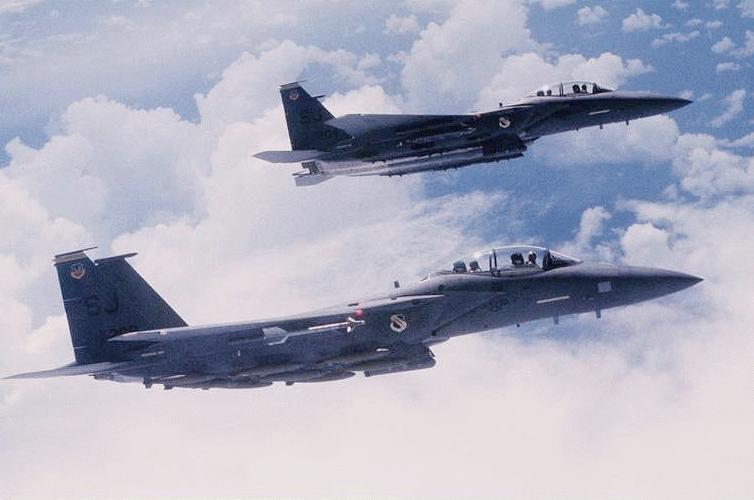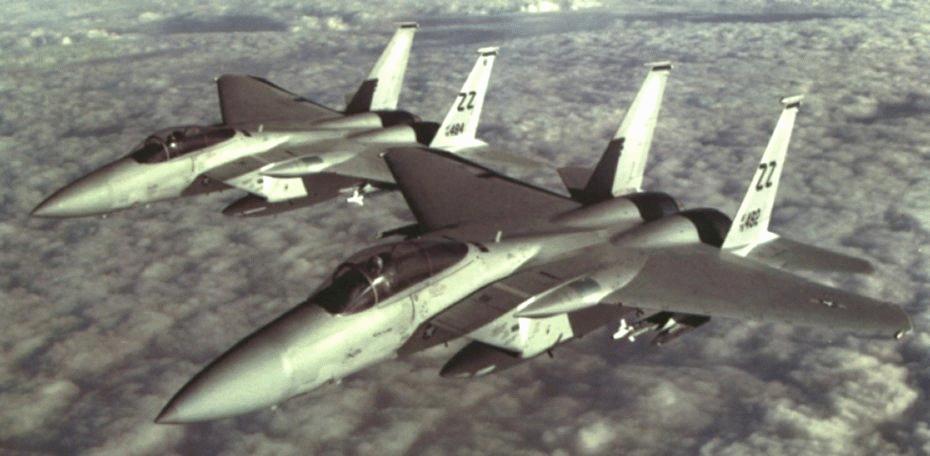The F-15 Eagle is an all-weather tactical fighter designed for air superiority. It has been the US Air Force's primary
air-to-air fighter since the 1970s.
The F-15 is such a good air superiority fighter because of its mixture of manouverability, acceleration, speed, range,
weapons and avionics. It can outperform nearly any enemy fighter aircraft today. The F-15 has electronic systems and weapons
to detect and attack enemy aircraft in friendly or enemy-controlled territory. The weapons and flight control systems are
designed so that one person can safely perform air-to-air combat.
The F-15's superior speed and manouverability are achieved through high thrust-to-weight ratio and low wing loading (the
ratio of an aircraft's weight to its wing area). This is a vital factor in manouverability and allows the F-15 to turn tightly
without losing airspeed.
The F-15's multimission avionics system includes a head-up display, advanced radar, inertial navigation system, flight
instruments, ultrahigh frequency communications, tactical navigation system and instrument landing system, as well as an internally
mounted tactical electronic warfare system, "identification friend or foe" system, electronic countermeasures set and a central
digital computer.
The first flight of the F-15A, which was the first version of the F-15 Eagle, happened on 27 July 1972. After an accident-free
test and evaluation period, the first aircraft was delivered to the US Air Force in November 1974. In early 1976 the first
F-15 destined for a combat squadron was delivered to the 1st Tactical Fighter Wing at Langley Air Force Base. Over 350 F-15As
were built before production of the F-15C began in 1979 and the A model was discontinued. F-15As are still in service with
the Air National Guard.

The two-seat F-15B first flew in July 1973, and the first aircraft was delivered to the 58th Tactical Training Wing at
Luke Air Force Base in November 1974, where pilot training was done in both F-15A and F-15B aircraft. The F-15B has two seats,
with a second crew member position behind the pilot's seat. The main role of the F-15B is aircrew training, with an instructor
pilot in the rear seat while a pilot in training flies the plane using the controls in the front. The rear seat pilot
has a full set of flight controls and can fly the aircraft, and even take-off and land just like the pilot in the front seat.
Even though space is sacrificed to accomodate the second crew member, the F-15B has the same warfighting capabilities as the
F-15A. Some F-15Bs are flown without crew members in the rear seat, since the rear seat is not a mandatory crew position.
The single-seat F-15C and two-seat F-15D models first entered the US Air Force in 1979. The F-15C is an improved version
of the original F-15A, with upgrades to avionics as well as an increased internal fuel capacity and a higher allowable
gross take-off weight. The C and D models have Production Eagle Package (PEP 2000) improvements, including 2,000 pounds
(900 kilograms) of additional internal fuel, the ability to carry external fuel tanks and an increased maximum take-off weight
of up to 68,000 pounds (30,600 kilograms). The F-15A and F-15C look so similar from the outside that it is almost impossible
to tell the difference between them.
The F-15D is the two-seat version of the single-seat F-15C. The primary purpose of the F-15D is the same as that
of the F-15B - aircrew training. A pilot in training mans the controls in the front seat while an instructor sits
in the rear seat. The F-15D is basically an upgraded version of the F-15B.
The F-15E Strike Eagle is the air-to-ground version of the F-15. It is designed to fight its way into enemy territory,
drop a bomb on a target and then fight its way out. Other than the fact that it can carry air-to-ground ordnance as well as
air-to-air missiles, the F-15E does not differ much from the ordinary F-15.
The F-15E is a two-seat dual-role fighter, capable of performing all-weather air-to-ground and air-to-air missions including
strategic strike, interdiction, OCA and DCA. It can also perform CAS and escort missions. F-15Es are equipped with LANTIRN,
enhancing night PGM delivery capability. The Strike Eagle's outboard and inboard wing stations and the centreline can be loaded
with various armament. The outboard wing hardpoints are unable to carry heavy loads and are used for electronic countermeasure
pods. The other hardpoints can be employed for various loads. The Strike Eagle entered service with the US Air Force in 1988.

The US Air Force is the primary user of the F-15, but some other countries use it as well. Israel uses F-15A, B and D
aircraft, as well as a version of the F-15 Eagle called the F-15I Thunder, which incorporates new and unique weapons,
avionics, electronic warfare and communications capabilities make it one of the most advanced F-15 variants. It has a night
vision goggle compatible cockpit, Elbit display and sight helmet (DASH) system, conformal fuel tanks and the ability to be
armed with AIM-7, AIM-9 and AIM-120 air-to-air missiles and a variety of air-to-ground weapons.
Israel selected the F-15I in 1994 and ordered 25 aircraft. In 1998 they ordered another 30 planes.
Saudi Arabia uses a version of the F-15 called the F-15S Peace Sun IX. Saudi Arabia also uses F-15C and D aircraft. The
F-15S is based on the F-15E, except it has downgraded avionics, downgraded LANTIRN pods and a simplified Hughes APG-70 radar
without computerised radar mapping. Saudi Arabia operates a fleet of 72 Peace Suns, all of which were delivered in 1999.
Japan has purchased and produced a total of 223 air-to-air F-15s called F-15J Peace Eagles. The F-15J is assembled in
Japan from largely indigenously manufactured sub-assemblies and equipment. The Mitsubishi F-15J/DJ Eagle is the principal
air superiority fighter operated by the JASDF. The F-15J is different from the F-15C/D because sensitive ECM, radar warning
and nuclear delivery equipment have all been removed. The AN/ALQ-135 is also replaced by indigenous J/ALQ-8
and the AN/ALR-56 RHAWS is replaced by J/APR-4.
There are plans to replace the F-15 in the US Air Force fleet with the newer F-22 Raptor stealth fighter. The F-15 is
still an excellent fighter aircraft, but studies have shown that foreign fighters, such as the Russian Su-35 and European
Eurofighter Typhoon can beat the F-15 in combat. However, there are no plans to replace the F-15E Strike Eagle and
Israel, Saudi Arabia and Japan will most likely continue to operate their fleets of F-15s.
The US Air Force has a total of 396 F-15s currently in active service, with 126 for the Air National Guard.
Primary function: Tactical fighter
Contractor: McDonnell Douglas Corporation
Powerplant: Two Pratt & Whitney F100-PW-100 turbofan engines with afterburners
Thrust: 25,000 pounds (11,250 kilograms) per engine
Length: 63 feet, 9 inches (19.43 metres)
Height: 18 feet, 8 inches (5.69 metres)
Wingspan: 42 feet, 10 inches (13.06 metres)
Maximum speed: Mach 2.5
Ceiling: 65,000 feet (19,700 metres)
Maximum take-off weight: 68,000 pounds (30,600 kilograms)
Range: 3,450 miles (3,000 nautical miles) ferry range with conformal fuel tanks and three external fuel tanks
Armament: One M61A1 internal multibarrel gun with 940 rounds of ammunition, four AIM-9L/M Sidewinder and four AIM-7F/M
Sparrow air-to-air missiles, or eight AIM-120 AMRAAM air-to-air missiles
Crew: F-15A/C - 1, F-15B/D/E - 2
Cost: $43 million
Date deployed: 1972

